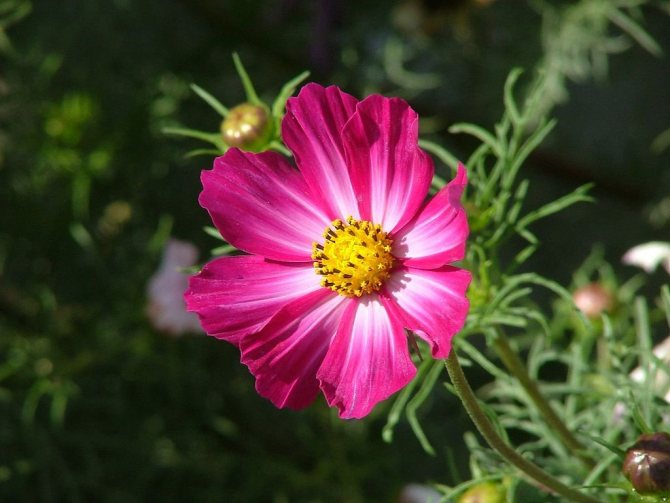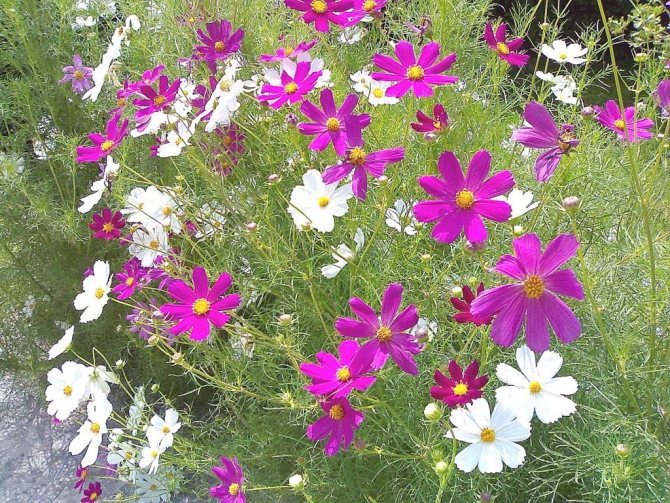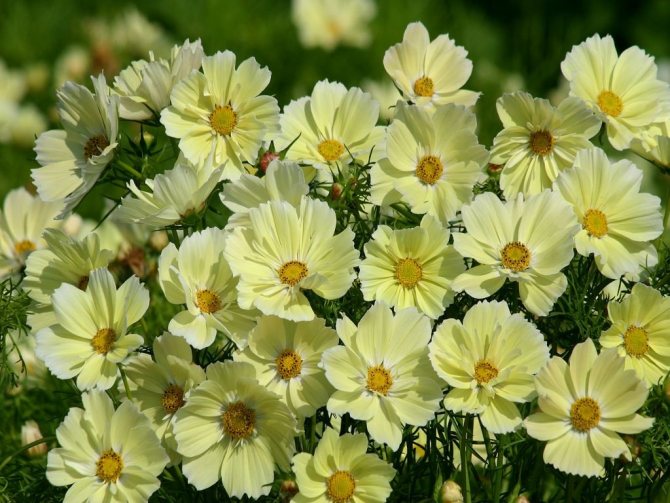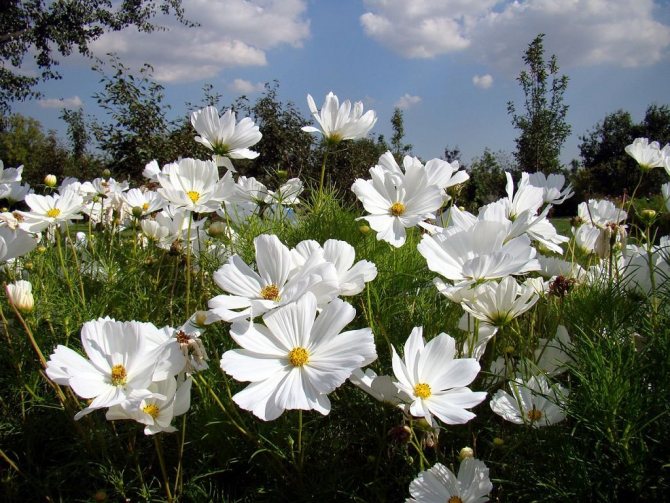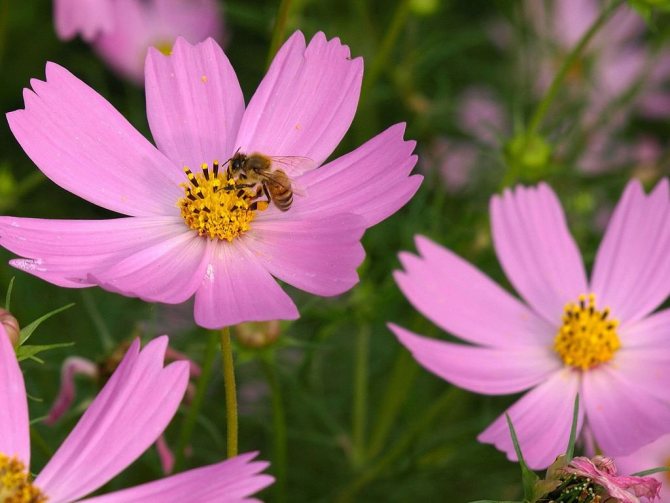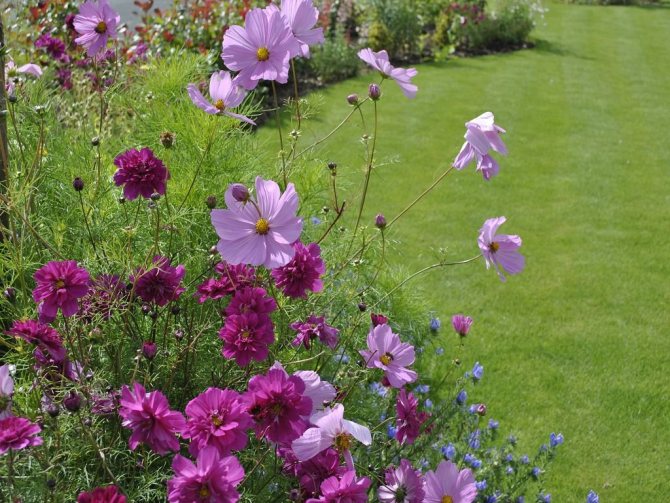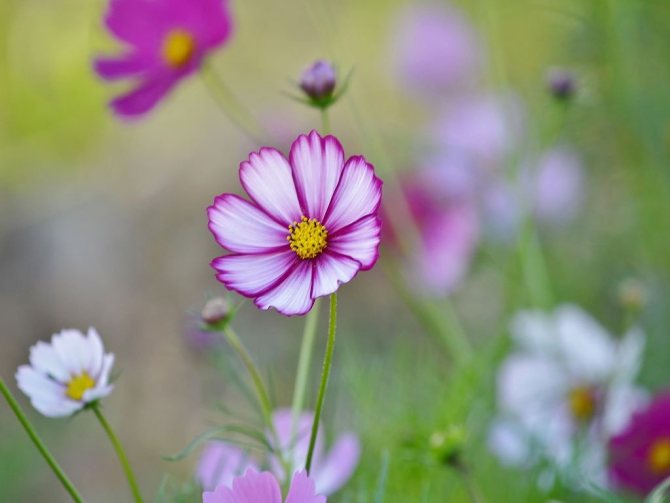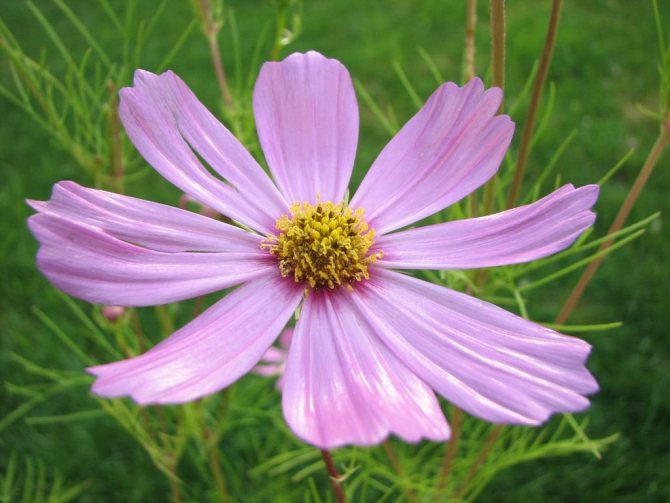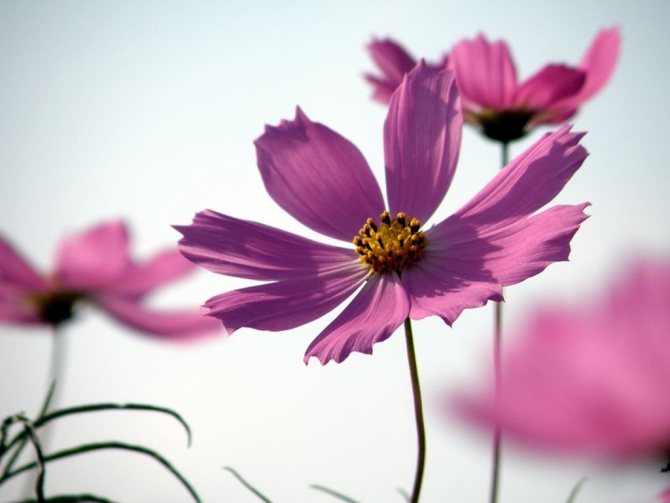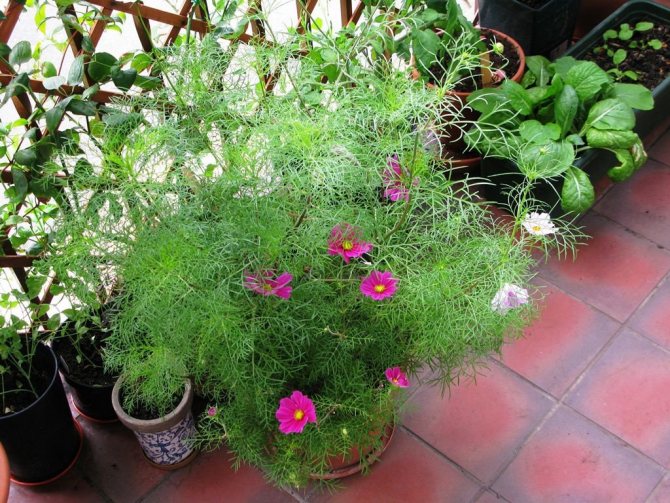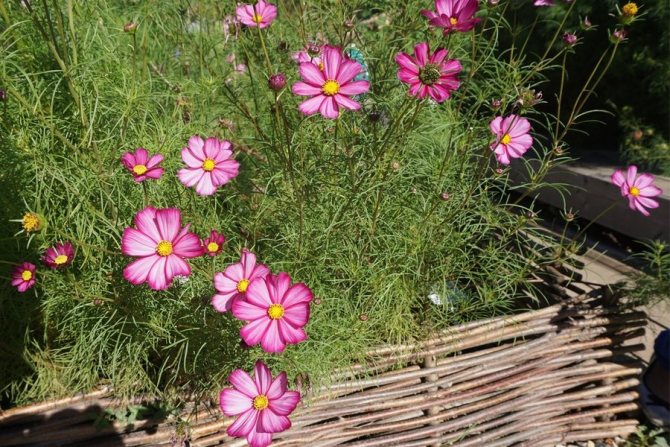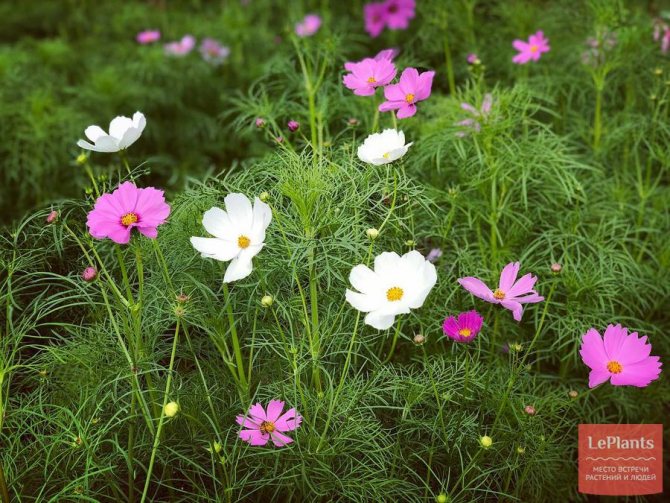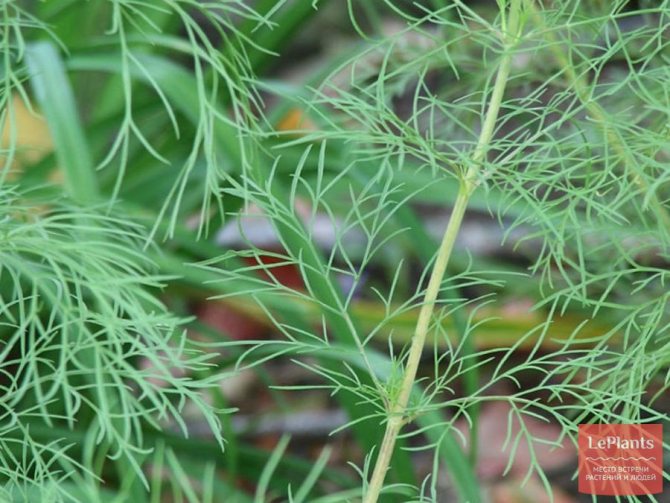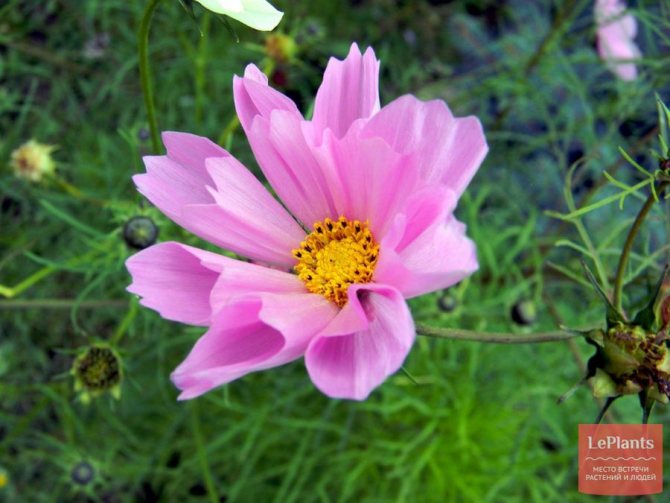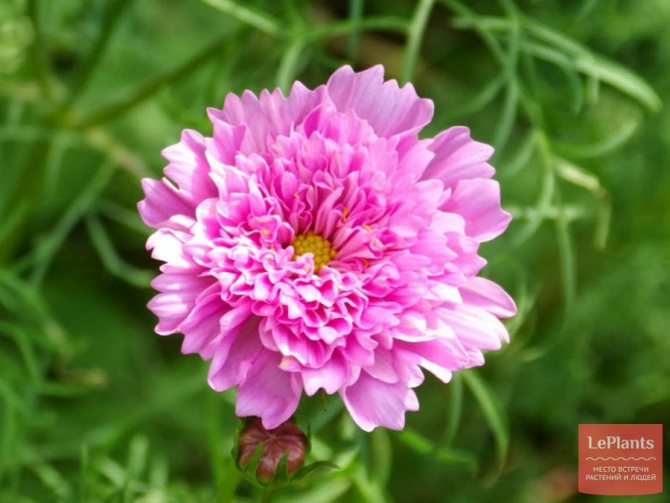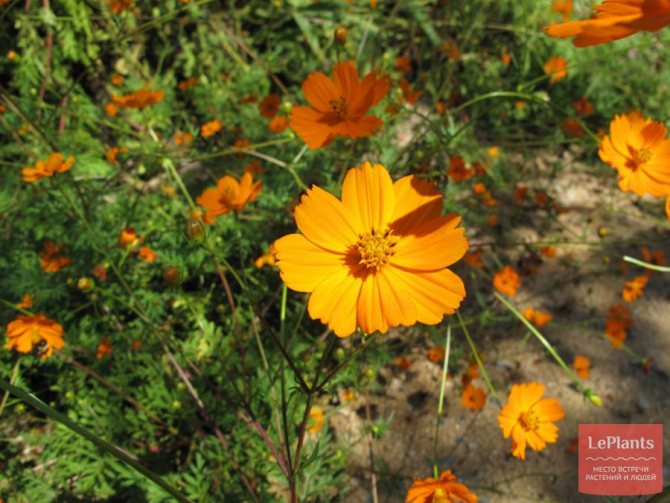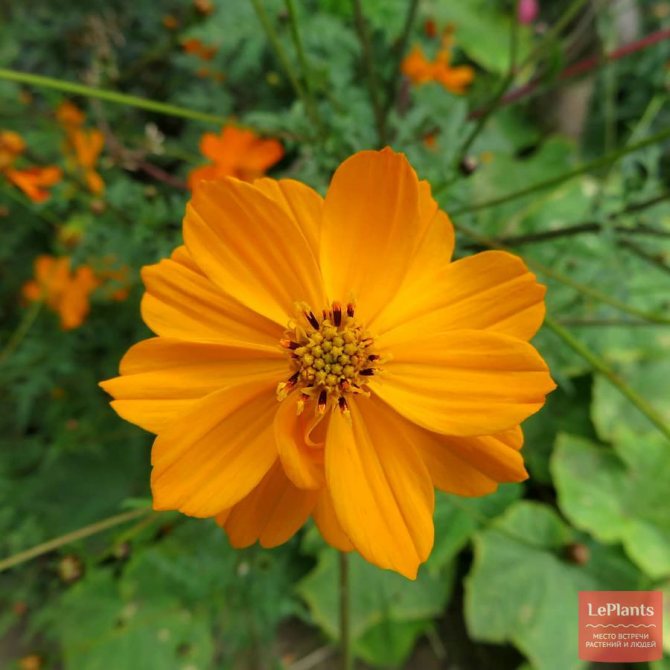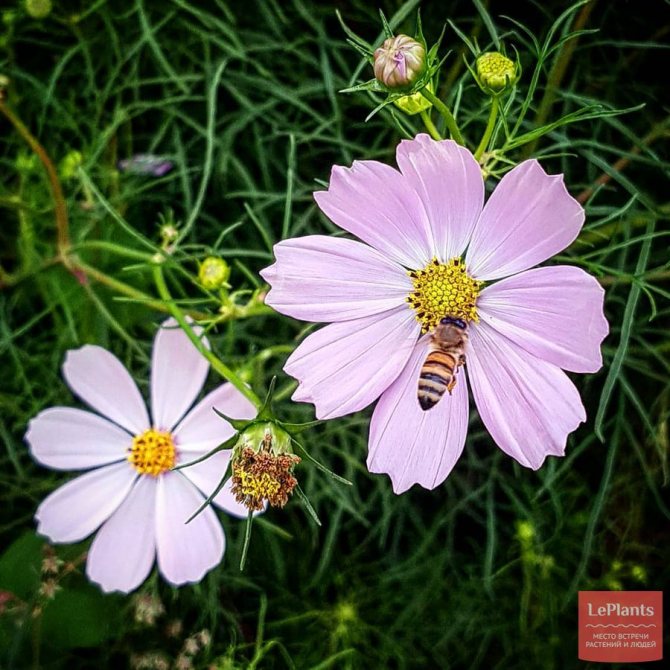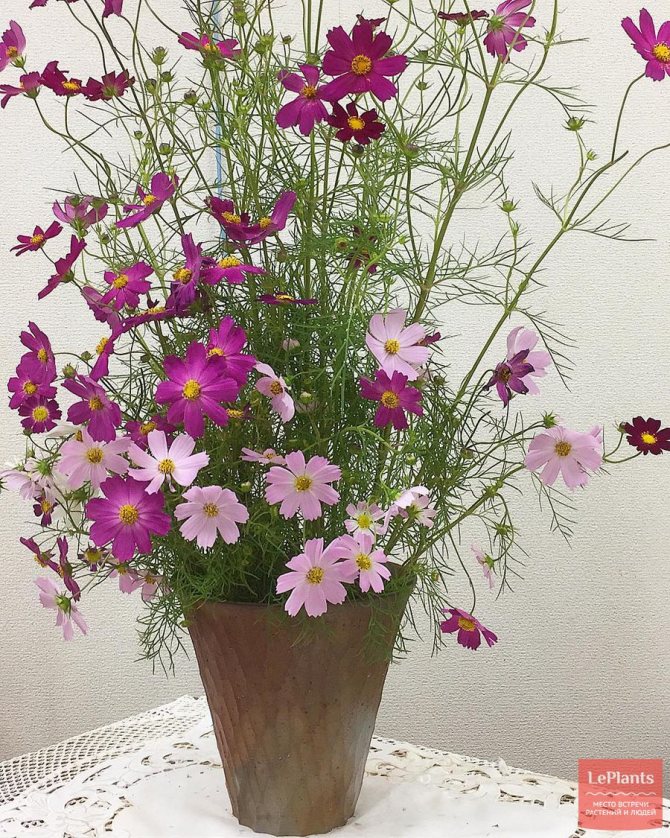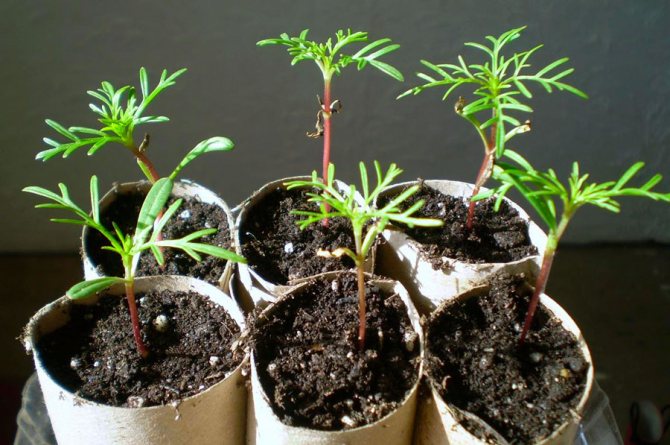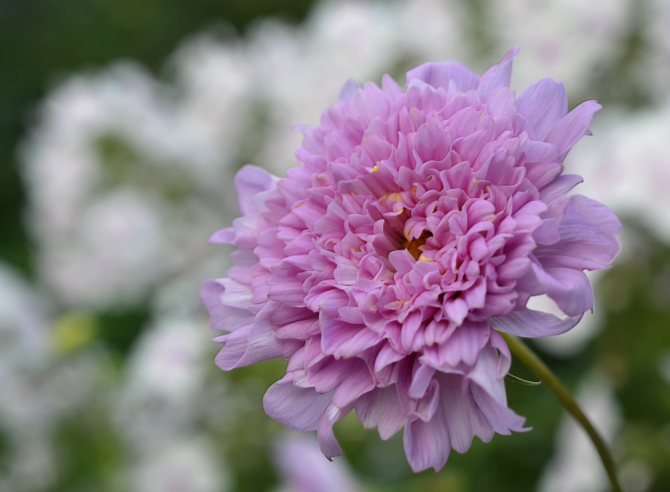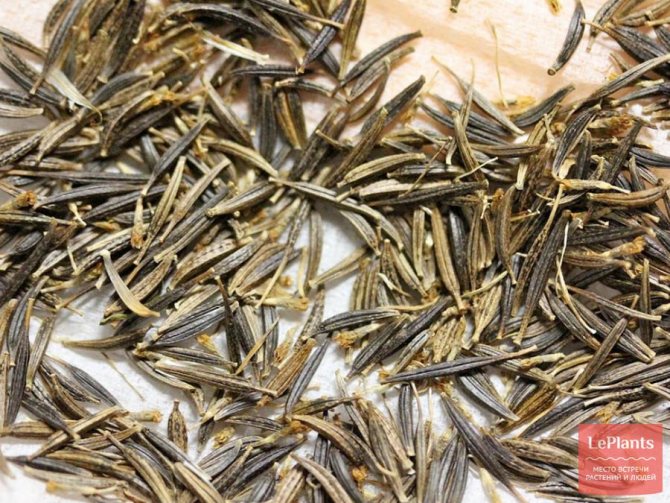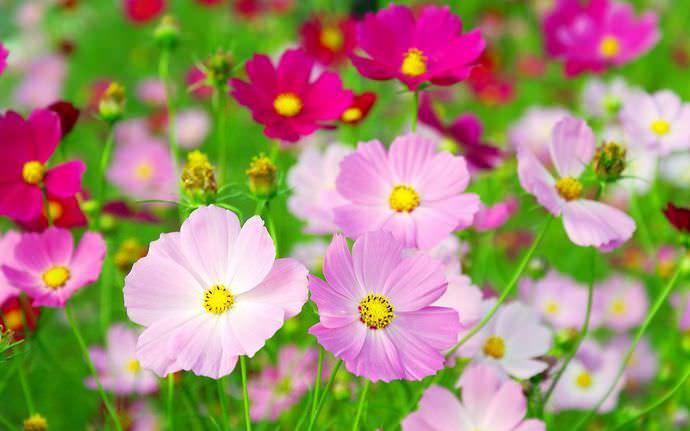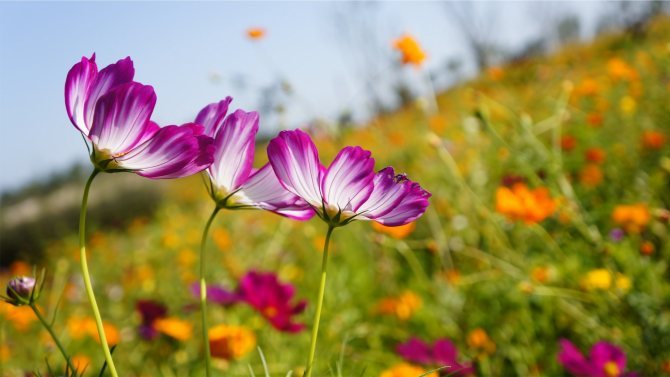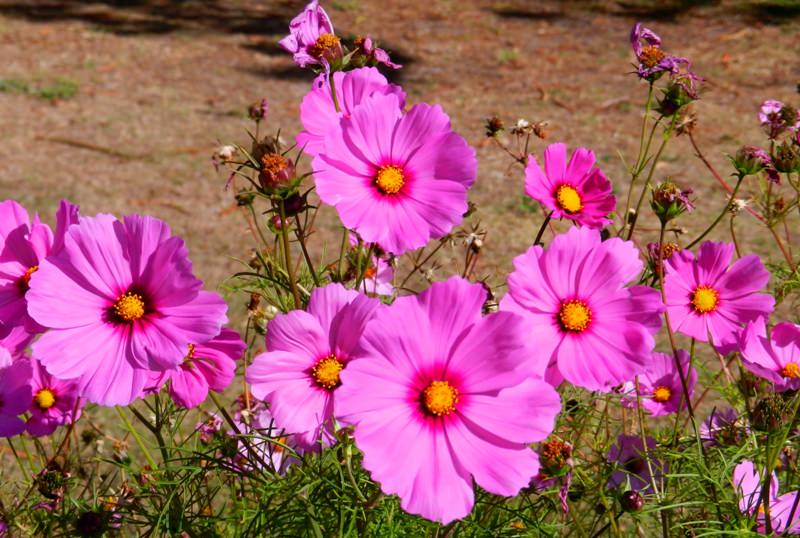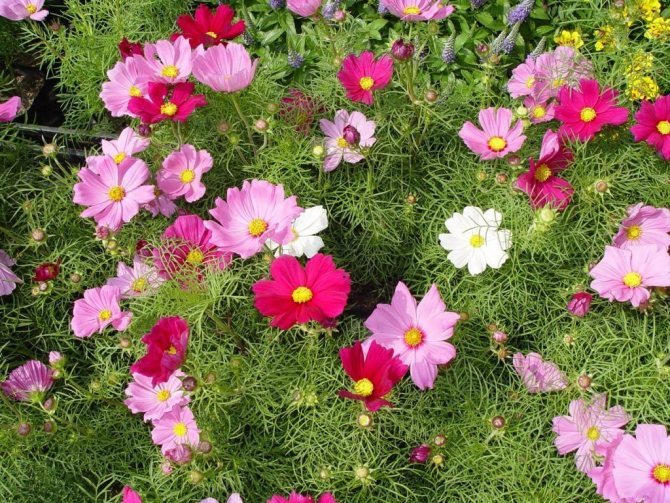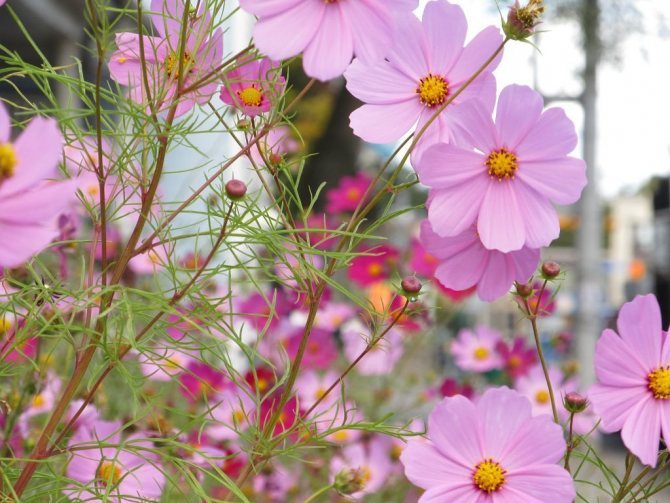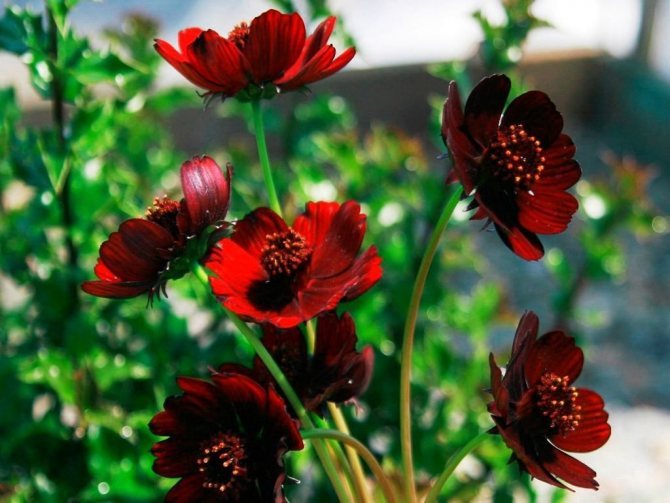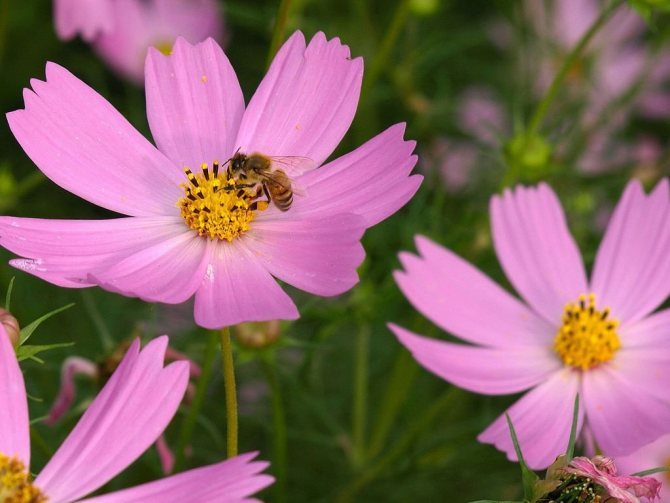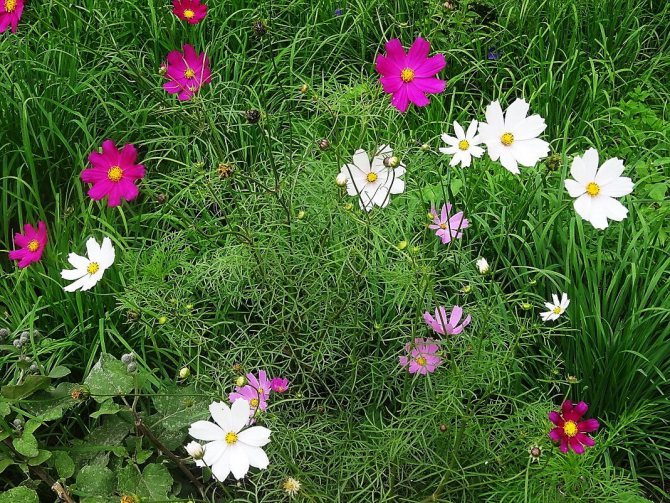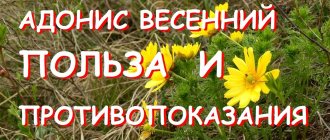Kosmeya is a herbaceous branching plant with bright and large flowers. Botany attributes the cosme to the Astrov family. For several centuries, flower growers all over the world have been using ornamental varieties of this plant to create flower beds and decorate gardens.
Kosmeya was discovered by missionaries in the central and southern regions of the New World, and from there it was brought to the European continent at the end of the 18th century. Perhaps for this reason it is often called the "Mexican aster".

It is said that the kosmeya got its name because of its height: it reaches 2.2 m. There is also an opinion that the missionaries named this flower so because of its sun-like core, surrounded by petals as if by planets. It can also be added that the etymology of the name is inexplicable, just as the cosmos itself is inexplicable.
This unpretentious and eye-catching flora will appeal to novice or time-limited growers. There are varieties that can winter in the south of our country, however, in the middle lane, the Mexican aster is mainly cultivated as an annual plant, changing the palette of colors every spring.
The airy flowers of the cosmos rise into the sky on thin stems that are almost invisible from a distance. Just like the stars - the more they are, the more beautiful they look. Kosmeya is able to decorate gardens until late autumn.
Description of the plant
Kosmeya is a herbaceous annual or perennial with thin, highly branched stems along the entire length. Its height is 50-150 cm. Shoots are covered with smooth bright green skin with reddish streaks. Opposite openwork leaves grow on them, which, together with the stems, form a spreading semi-shrub, similar to airy green foam. The segment of the leaf adjacent to the long petiole is oval with a pointed edge or thin, similar to soft needles.
Cosmos bloom begins in June and lasts until the first frost. In the upper part of the processes, there are scutellous or paniculate inflorescences. Each flower is an inflorescence-basket with a diameter of 6-12 cm. It has a fluffy center of tubular flowers of black or dark brown color. Yellow anthers rise above it. The core can be flat or spherical. It is edged with one or more rows of reed flowers with golden, red, white, pink or purple petals. The reed flower petals can grow together to form a flat sail or form a more decorative one-piece bell.
Plants are pollinated by insects, after which dry achenes with a lush tuft ripen. Elongated dark brown seeds remain viable for up to three years.
Mr. Summer resident informs: the reasons why cosmeya does not bloom
The following can be distinguished:
- Late landing. If this is not done on time, then the flower may not have time to open.
- Excessive feeding of the plant. Due to the fact that the land in which the flower grows is excessively fertile, all his forces go to increase the green mass: tall and thick stems, large leaves. To avoid this, you should control the time and amount of fertilizer applied.
- Violation of the rules of care (overflow, placement in the shade) can lead to poor flower opening.
Garden varieties
The genus of cosmos is not very extensive. It contains about 24 species.In culture, only 3 main varieties and a huge number of decorative varieties are used.
Cosmeya is double-feathery. The popular garden annual is distinguished by thin, dill-like or needle-like leaves of bright green or olive color. The height of highly branched erect vegetation is 80-150 cm. In the upper part of the shoots, inflorescences-baskets with a diameter of 7-10 cm are formed. Each one grows on a separate peduncle, thin as a thread. The convex center is covered with large yellow stamens. Along the edges are a series of reed flowers of purple, pink, red or snow-white color. A narrow linear petal has a wavy or rounded edge. Varieties:
- Puriti - filamentous stems end with snow-white flowers with wide, triangular petals;
- Radiance - corrugated petals expand towards the edge, forming a solid circle, there is a contrasting spot on the petals closer to the center.


Cosmeya double-feathered
Kosmeya is sulfur-yellow. The heat-loving variety has more dense branched shoots covered with pinnately dissected foliage. Individual segments of the leaf are wider. They are colored dark green. Vegetation up to 1.5 m high ends with bright orange flowers up to 5 cm in diameter. The core is taller and denser than that of the previous species. It consists of golden tubular flowers with dark brown anthers on top. The inflorescence is surrounded by corrugated bright orange petals with a wavy edge. Varieties:
- Bilbo - golden orange semi-double flowers bloom on stems about 50 cm high;
- Diablo - blooms bright red, simple buds.
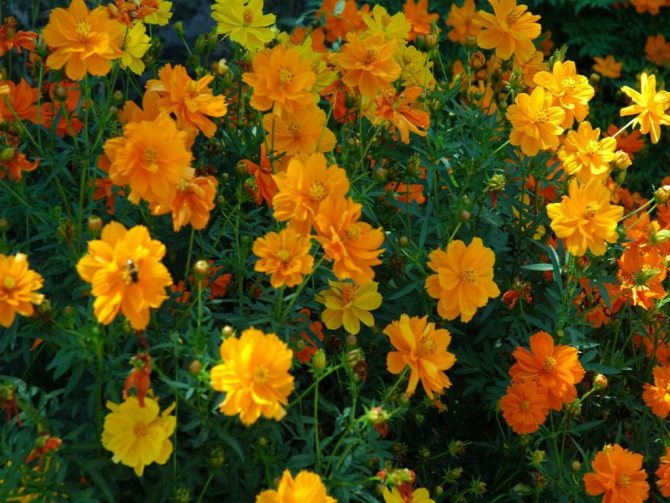

Kosmeya sulfur-yellow
Cosmeya is blood-red. The variety looks very unusual, thanks to its large flowers with maroon petals and an almost black core. The surface of the petals is matte, as if velvety. During the flowering period, a sweetish chocolate aroma spreads over the flower bed. Under the flowers on the stems there are dark green odd-pinnate leaves.
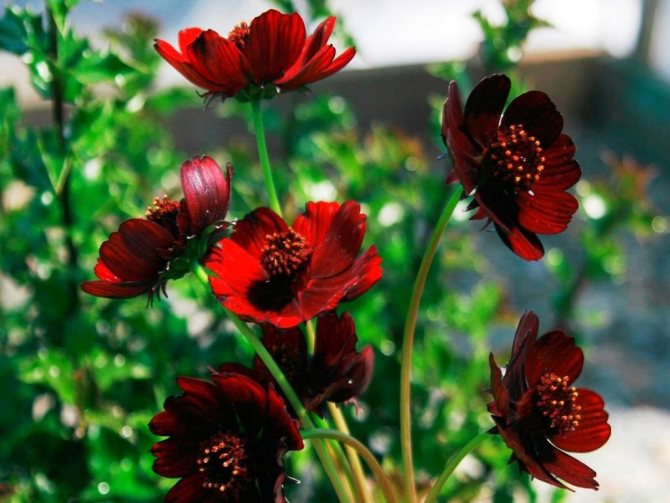

Kosmeya blood red
Recently, many varieties with lush flowers have appeared, which are combined under the name terry kosmeya... This group is not represented in the official classification as a separate species. However, it is very popular with gardeners. Varieties:
- Ladybug - a bush up to 30 cm high blooms with yellow, red or orange semi-double inflorescences up to 7 cm in diameter;
- Sunny Gold - bright yellow double flowers over low emerald growth;
- Rose Valley - light pink inflorescences up to 10 cm in diameter consist of several rows, shortening to the center of the petals.
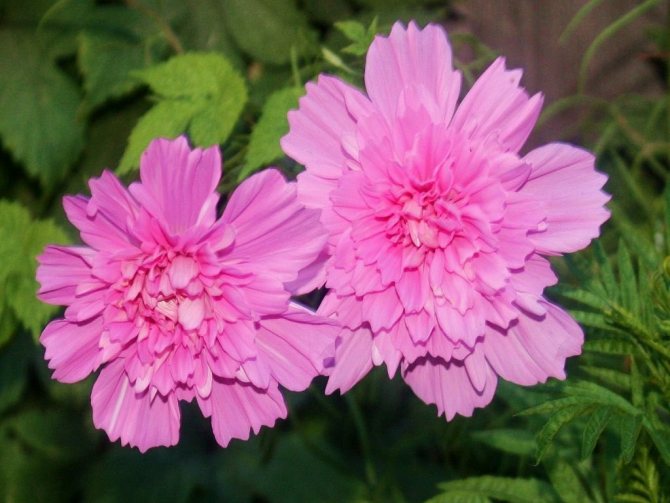

Terry kosmeya
Content
- Listen to the article
- Description
- Growing cosmos from seeds Sowing
- Seedling care
- Planting cosmos When to plant
- How to grow
- How and when to collect seeds
- Cosmos bipinnatus
Growing cosmos
In temperate climates, even perennial kosmeya is cultivated as an annual, therefore, it is considered a seed method for its reproduction. Sowing seeds in open ground or preliminary cultivation of seedlings is allowed. When sowing cosmos in the garden, flowering will not begin until the end of July. As soon as the snow melts, shallow holes are prepared. Seeds are distributed in groups of 3-4. with a distance of 30-40 cm. They are embedded to a depth of 1 cm. After planting, the soil is carefully watered. In the future, the seedlings are looked after as for adult plants. Only at first, watering should be careful not to wash the plants out of the soil. Too dense places are slightly thinned out.
When growing in one place, kosmeya gives abundant self-seeding.In this case, it is not necessary to sow it specially in spring, since young plants will certainly appear on their own. It is enough just to thin them out and give the landings the desired shape.


If you pre-grow seedlings, then the first flowers of the cosmos can be seen already at the beginning of June. To do this, seeds are sown in shallow boxes with a sand-peat mixture already in the first decade of March. They are only pressed lightly into the soil so that light hits the surface of the seed. The room temperature should be + 18… + 20 ° C. Seedlings appear in 1-2 weeks. When the seedlings grow slightly, they are dived into another box with a distance of 10-15 cm. After the dive, the kosmeya is transferred to a room with a temperature of + 16 ... + 18 ° C.
Perennials can also be propagated by tubers and cuttings. The tubers are dug up in the fall, separated and stored all winter in the basement in wet sawdust. In the spring they are planted in the garden. Cuttings are cut and rooted outdoors during the summer.
Wintering
For most of Russia, it will be relevant to take additional measures to protect the dormant plant in the winter. Namely:
- If the frosts are already strong, and there is little snow, do not be too lazy to throw the snow that has already fallen on the sleeping shoots. A layer of snow will protect well from frost.
- Until the snow has fallen, and the nights are already getting cold, it does not hurt to sprinkle the wintering shoots with stove ash. Ash will not only warm the plants, but also fertilize the soil and protect them from pests in the spring.
Planting and leaving
Seedlings are moved to open ground at the end of May, when the danger of recurrent frosts has finally disappeared. All types of cosmos do not tolerate negative temperatures, and young plants are even more sensitive to cold snaps. When planting, the height of the plants should reach 6 cm or more.


Cosmey is best planted in an open, sunny area. Strong drafts and gusts of wind can break thin stems. The soil should be moderately nutritious and light, without stagnant water. A neutral or slightly acidic reaction is optimal. On too fertile land, greenery will develop better, and flowering will decrease.
For planting, shallow pits are prepared with a distance depending on the height of the variety (about 30-35 cm). After planting, the plants are well watered. For tall grades, you should immediately think about a garter or supports. Already now you can dig in the stakes and pull the rods. To make the stems branch out better, they are pinched.
Kosmeya does not retain moisture well, so it needs to be watered often and abundantly. On hot days, 1-2 times a week, up to 4-5 buckets of liquid are poured under the bush. The soil should be loosened regularly to break up the dense crust after watering. Weeds also need to be removed. In young plants, their growth slows down significantly from their dominance.
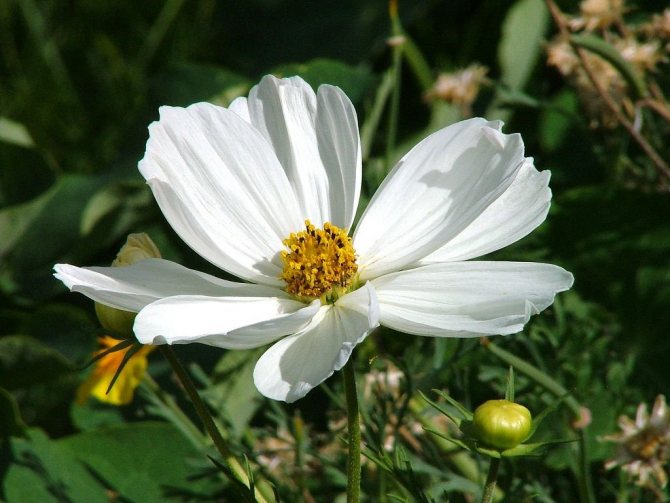

Since the beginning of summer, once or twice a month, cosmea is fertilized with flowering stimulants ("Bud"). The solution is not only poured into the soil at the roots, but also sprayed over the leaves. Mineral or organic fertilizing (Agricola, superphosphate, rotted manure) is introduced several times per season. Such fertilization is necessary only on depleted soils.
In order for flowering to last for a long time, it is recommended to immediately cut off wilted inflorescences. Then new buds will appear in their place. In the southern regions, in order to preserve the cosmos for the winter, at the end of autumn, remove the ground part to the very ground, or leave no more than 10-15 cm of shoots. They are covered with a thick layer of fallen leaves and spruce branches. In early spring, the shelter should be removed so that the sprouts do not squeeze. In more northern areas, a flower garden in the middle of autumn is dug up and all parts of the plant are removed.
The advantage of cosmos is strong immunity and resistance to parasites. In too dense plantings, snails and slugs sometimes settle. They are collected by hand, and ash and crushed eggshells are also scattered on the ground as a barrier.
How to care
Despite the fact that the guest has moved to us from warm regions, even in the northern area it will grow excellently.And if the planting process cannot be called laborious, then it is even easier to care for the cosmos.
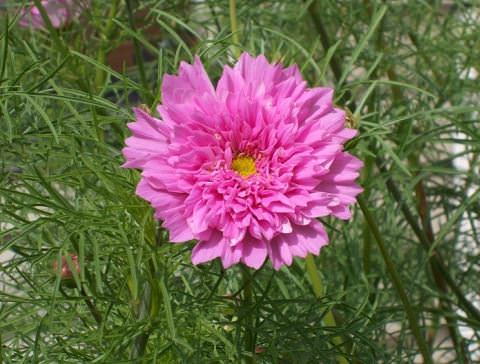

The huge advantage of the plant is that it is not affected by pests. In fact, the mandatory procedures are limited to systematic watering, about once a week. But there are little tricks that can help make the flower even more beautiful:
- To make the flowers stronger and larger, and the leaves even more luxuriant, you can sometimes organize weeding and loosen the soil from time to time.
- If the plants are stunted and noticeably suffer from a lack of nutrients, it is advisable to fertilize the soil, for example, with double superphosphate. It is better to do this not during the period of abundant flowering, but when the buds have just begun to form.
- Tall plantings sometimes suffer from strong gusts of wind. So that the stems do not break and the flowers do not crumple, it is better to carefully tie the plant up.


- If you remove the already faded buds, new flowers will appear faster, the flower bed will become much neater. As soon as the autumn frosts begin, the stems are cut off, more often at the surface of the ground, but about 15 centimeters of the stem can be left. The largest and most beautiful faded buds can be left for new seeds to ripen.
Kosmeya in landscape design
The abundance of flowers and shades of the plant allows you to make the landscape design surprisingly harmonious. The plant is ideal for imitating a natural meadow and country garden, it will turn out to be very cute and romantic. The company will be made up of chamomiles, annuals, phlox, marigolds.


Tall varieties with a straight stem, which sometimes reaches 150 centimeters, are often planted along the fence, hiding, for example, unsightly trellises. You can also successfully decorate the border or create a decorative corridor of flowers along the path. Such a natural fence is trimmed if desired. In addition, tall kosmeya is good in delicate bouquets.
Low-growth varieties look good against the background of other plants. The borders of the flower garden are easily formed from them, it is enough to limit the zones with the help of ordinary wire. When the plantations grow, it will be invisible.
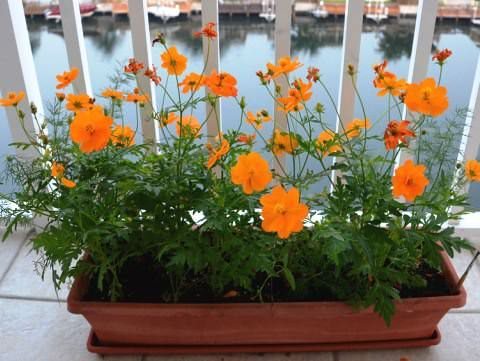

Plant use
Openwork greenery and delicate flowers look simply charming anywhere. Cosmeya can be planted on the street along the fence, at the curb, in the flower garden. A subtle tart aroma spreads over the bright baskets. It is framed by bushes and trees, and is also planted between vegetable beds. In the latter case, the beauty is also beneficial. She turns the garden into a flower garden and at the same time protects vegetables from the scorching sun with openwork leaves. At the same time, enough light passes through the lace leaves.


In a flower bed, the plant is absolutely non-aggressive. Cosmey is combined with chamomiles, mallow, lilies, geraniums, asters, calendula, alissum, cloves, salvia or bells. When choosing a place and neighbors in a flower bed, the color of the petals and the height of the plant are taken into account. It can also be planted in flowerpots and brought indoors for the winter.
Collecting seeds
If the annuals of the cosmos are propagated by seeds, then the perennial flowers are grown by the tuberous method and cuttings. After the initial planting, annuals reproduce by self-seeding. How to collect seeds for maximum germination?
- We leave several large buds on the bush.
- We put gauze on them to prevent the seeds from falling to the ground.
- The seeds are harvested as soon as they turn dark.
- Since the crop is cross-pollinated, seeds collected from cosmos may not retain their varietal properties. So, by and large, it is much easier to buy the seeds of the variety you need in the store than to try to grow some kind of hybrid from those collected by yourself.

